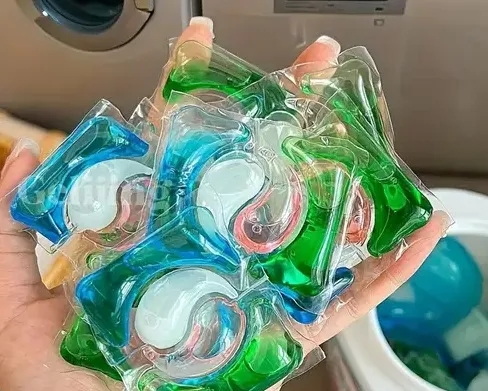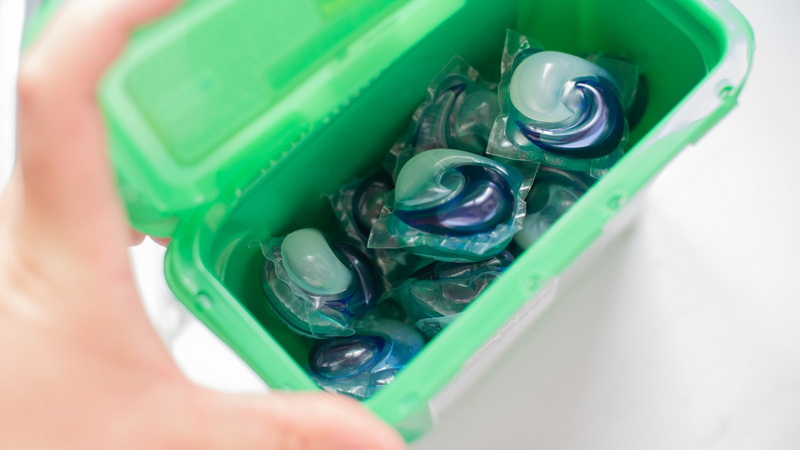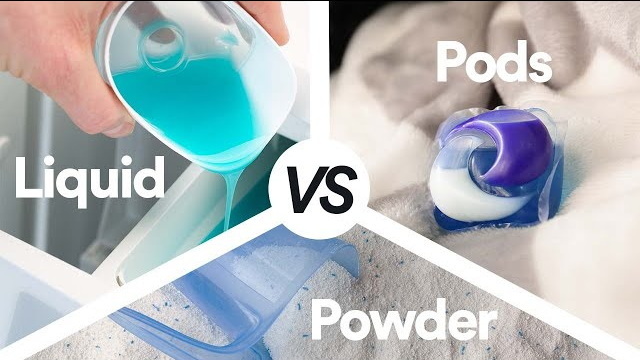Dongguan UFine Daily Chemical Co.,Ltd.
- All
- Product Name
- Product Keyword
- Product Model
- Product Summary
- Product Description
- Multi Field Search
Views: 222 Author: Tomorrow Publish Time: 11-17-2025 Origin: Site











Content Menu
● What Is a Laundry Detergent Pod?
● Ingredients Found in Laundry Pods
>> 1. Risk of Accidental Ingestion
● Safety Regulations and Industry Standards
● How to Respond to Accidental Exposure
● Environmental and Sustainability Considerations
● Comparing Pods With Other Detergent Types
● Are Laundry Detergent Pods Safe for Sensitive Skin?
● Alternative Eco-Friendly Laundry Solutions
● AQ
>> (1) Are laundry detergent pods safer than liquid detergent?
>> (2) Can detergent pods cause allergic reactions?
>> (3) How should detergent pods be stored?
>> (4) Do detergent pods dissolve completely in cold water?
>> (5) Are detergent pods environmentally friendly?
Laundry detergent pods have revolutionized the way people do laundry, offering a mess-free, pre-measured solution that saves time and effort. However, despite their convenience, questions about their safety continue to arise. Many consumers wonder whether laundry detergent pods are truly safe to use around children, pets, and sensitive individuals—and whether their environmental footprint aligns with sustainable living.

A laundry detergent pod, sometimes called a capsule or pack, is a small water-soluble packet filled with concentrated laundry detergent. The pod's outer film is typically made of polyvinyl alcohol (PVA), a material designed to dissolve entirely when immersed in water. Inside, the pod contains a mixture of cleaning ingredients including surfactants, enzymes, brighteners, and stain removers.
Most modern detergent pods feature a multi-chamber design that keeps specific ingredients separate until the wash cycle activates. This technology enhances cleaning performance by releasing each component at the right time in the washing process. For consumers, the major advantages are convenience, accurate dosing, and reduced detergent waste.
The rise of detergent pods has been driven largely by convenience. For busy households, pods eliminate the need to measure liquids or powders. You simply drop one into the washer drum before adding clothes.
Beyond convenience, pods also:
- Save storage space due to compact packaging.
- Prevent detergent spills that can occur with liquid or powder forms.
- Offer consistent cleaning results thanks to precise measuring.
- Work effectively in both front-load and top-load washing machines.
- Reduce the likelihood of overdosing, which not only harms fabrics but may also leave residue in machines.
Yet, while pods simplify laundry routines, their concentrated nature introduces safety and environmental challenges that require careful attention.
Understanding what is inside a detergent pod can clarify potential safety concerns. Common ingredients include:
- Surfactants: Active cleaning agents that lift dirt and oil from fabrics.
- Enzymes: Biological components that break down protein-based stains such as food or sweat.
- Builders: Compounds that soften water and enhance cleaning performance.
- Optical brighteners: Chemicals that make fabrics appear whiter and brighter.
- Fragrances and dyes: Add pleasant scents and visual appeal to the product.
- Preservatives: Prevent microbial growth in the formula.
The high concentration of these chemicals makes pods powerful cleaners but also more hazardous if misused or ingested. Even small amounts can cause chemical burns or poisoning in children and pets.
Laundry detergent pods are small, colorful, and soft to the touch—features that can make them appealing to young children or pets. Accidental ingestion incidents have been reported worldwide, leading to symptoms such as vomiting, coughing, or difficulty breathing. Severe cases can cause esophageal burns or aspiration into the lungs.
Poison control centers often receive calls about detergent exposure, particularly among children under the age of five. The concentrated mixture in pods poses greater risks than standard diluted liquid detergent.
If a pod bursts during handling, the detergent may splash into the eyes or onto the skin. This can cause itching, redness, or burning sensations. People with sensitive skin or eczema may also react to residual chemicals left on clothing after washing.
To reduce risk, users should handle pods with dry hands, avoid puncturing or squeezing them, and always wash hands after handling laundry.
Pets, especially dogs, may find the smell or texture of detergent pods enticing. Chewing or biting into a pod can release concentrated detergent leading to drooling, vomiting, or respiratory distress. Veterinary clinics have reported a growing number of such cases, underscoring the need for safe storage practices.
Although detergent pods eliminate plastic bottles, concerns persist regarding the biodegradability of PVA film. Some studies show that not all polyvinyl alcohol completely degrades in wastewater treatment facilities, contributing to microplastic accumulation. Incomplete breakdown could allow residues to enter waterways and affect aquatic ecosystems.
Government agencies and industry organizations have taken measures to reduce the risks associated with detergent pods:
- Child-resistant packaging: Many countries require detergent pod containers to feature locking lids or re-sealable designs that meet child safety standards.
- Bittering agents: Some manufacturers add a bitter taste to discourage ingestion.
- Clear labeling: Warning labels and emergency instructions are mandatory on most packaging.
- Public awareness campaigns: Organizations such as the American Cleaning Institute and the European Chemicals Agency promote educational messages on safe usage and storage.
Regulatory compliance ensures that manufacturers meet minimum safety standards, but consumer awareness remains the best defense against accidents.

To make laundry detergent pods safe for household use, consider these practical tips:
1. Store securely: Keep pods in locked cabinets or high shelves beyond children's and pets' reach.
2. Handle carefully: Always use dry hands to prevent premature melting of the film.
3. Avoid pre-handling: Place the pod directly in the washer drum before adding clothes.
4. Keep original packaging: Containers are often designed with safety mechanisms and proper labeling.
5. Educate family members: Teach children about the dangers of touching or playing with cleaning products.
6. Avoid transferring to other containers: Repacking can remove safety locks and create confusion.
7. Dispose responsibly: Throw damaged or unused pods away according to local waste management guidelines.
Consistent adherence to these habits significantly reduces the likelihood of exposure or poisoning incidents.
Knowing how to react quickly can prevent serious harm:
- If swallowed: Do not induce vomiting. Rinse the mouth thoroughly and call poison control or emergency services immediately.
- Eye exposure: Flush eyes with clean water for 15–20 minutes and seek medical advice promptly.
- Skin contact: Rinse with water and mild soap; if irritation persists, consult a healthcare provider.
- Inhalation: Move the affected person to fresh air. If symptoms such as coughing or dizziness occur, seek medical attention.
Always have emergency contact numbers visible near the laundry area.
As sustainability awareness grows, detergent pod manufacturers are under pressure to prove the eco-friendliness of their products. Some steps being taken include:
- Improving PVA film biodegradability: Research focuses on reformulating films that degrade faster in varying water temperatures.
- Plant-based surfactants: Replacing petroleum-derived components with renewable ones reduces environmental impact.
- Concentrated formulations: Using less water in production decreases transportation weight and packaging size.
- Recyclable containers: Shifting to cardboard or easily recyclable plastic improves waste management efficiency.
Consumers can contribute by choosing certified eco-friendly brands and avoiding overuse—one pod per full load is generally sufficient.
| Feature | Liquid Detergent | Powder Detergent | Detergent Pod |
|---|---|---|---|
| Ease of use | Moderate | Low | High |
| Dosing accuracy | Medium | Low | High |
| Cleaning power | High | High | Very high |
| Safety risk (children/pets) | Low | Moderate | Higher |
| Environmental impact | Medium | Low | Variable |
| Cost per load | Moderate | Low | Slightly higher |
This comparison shows that while pods outperform in convenience and cleaning power, they carry higher safety risks if misused and come at a higher cost per wash load.
Those with allergies or sensitive skin should use fragrance-free or hypoallergenic pods. Pods labeled “Free & Clear” avoid dyes and strong chemicals that can irritate delicate skin. Always read ingredient lists carefully, as even some hypoallergenic formulas may contain small traces of preservatives or surfactants that trigger reactions.
When washing baby clothes, bedding, or towels for sensitive individuals, choosing mild, dermatologically tested pods offers better safety and comfort.
Countries worldwide are implementing safety standards for detergent pods. For example:
- In the United States, the ASTM International created voluntary safety standards addressing child-resistant packaging and performance testing.
- In the European Union, Regulation (EC) No 1272/2008 mandates hazard labeling for chemical mixtures, including laundry products.
- Australia and Canada have adopted similar packaging and labeling requirements, accompanied by awareness programs through poison control centers.
These measures aim to reduce accidental exposures while ensuring that manufacturers communicate risks clearly and effectively.
Those who feel hesitant about detergent pods can consider alternatives that balance safety, effectiveness, and environmental responsibility. Popular choices include:
- Liquid or powdered detergents: Easier to control and generally less concentrated.
- Laundry sheets: Thin, dissolvable sheets made from plant-based films.
- Soap nuts or natural detergents: Derived from plants that naturally produce surfactants.
- Homemade detergents: Made with simple, safe ingredients like baking soda and washing soda.
While pods remain dominant in convenience, these alternatives provide options for households prioritizing safety and sustainability.
Laundry detergent pods offer undeniable convenience, efficiency, and consistent dosing for busy households, but safety must remain the priority. Their concentrated chemical content makes them hazardous when mishandled or left within reach of children and pets. Although industry regulations and improved packaging reduce risks, education and responsible storage are still essential.
From an environmental perspective, biodegradable films and plant-based formulations represent progress but not a complete solution. Sustainable choices depend on both manufacturers' innovation and consumer awareness. When used correctly, detergent pods are safe, effective, and compatible with most washing machines—yet they will always demand careful handling and intelligent use.

Not necessarily. Pods provide precise measuring and prevent spills, but their compact form and bright design make them more attractive to children and pets. Safety depends on proper storage and cautious handling.
Yes. Some pods contain fragrances and enzymes that may irritate sensitive skin. Using hypoallergenic or dye-free pods can help reduce allergic responses.
Keep pods in their original packaging, preferably with child-resistant features, and place them high or locked away from children and pets. Avoid humid areas where moisture might dissolve the film.
High-quality pods are formulated to work in both hot and cold water. However, using extremely short or low-water cycles might prevent full dissolution, leading to residue on fabrics.
Manufacturers claim that PVA films dissolve in water, but some researchers question their complete biodegradability. Choosing eco-certified brands or plant-based alternatives can minimize impact.